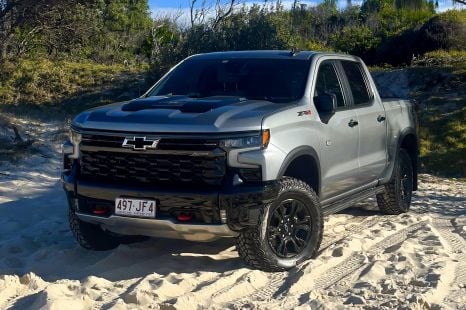

William Stopford
2025 Chevrolet Silverado ZR2 review
1 Month Ago
With its unique turbo petrol engine in a market that's more open to diesels than ever, the Amarok Aventura sits nicely in its own zone.
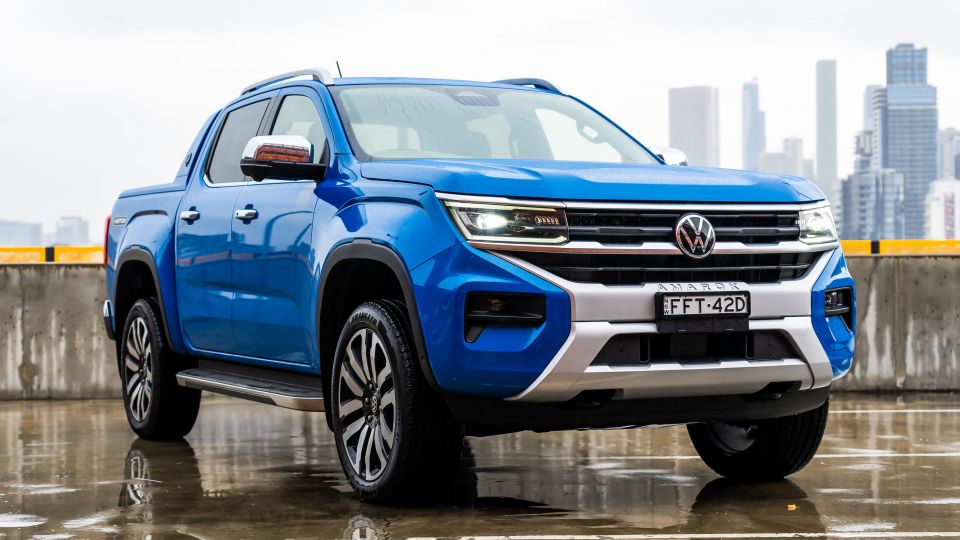
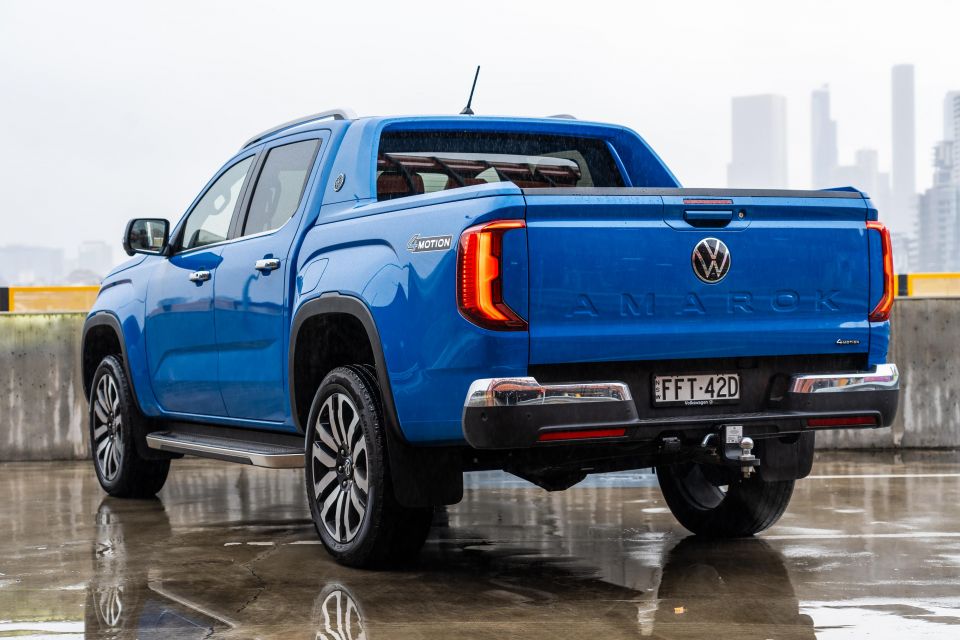

Quickly see how this car stacks up against its competition. Select any benchmark to see more details.
Where expert car reviews meet expert car buying – CarExpert gives you trusted advice, personalised service and real savings on your next new car.
The foreman has arrived.

It’s the Volkswagen Amarok of course, but not one we’d be expecting is put to work with its low-profile tyres and unique engine.
While the original version got rid of its petrol powertrain long ago, this latest generation of Amarok has added one back.
It’s quite the contrast to what most people tend to go for in Australia, because in rivals like the Toyota HiLux, Nissan Navara, and even other Amaroks, the diesel engine is generally the pick of the bunch… or the only option.
The current Amarok shares most of its oily bits with the Ford Ranger. That partnership brought with it a turbocharged petrol engine Volkswagen has chosen to employ as an option only at the top of the model range.
On test here is the equal-most expensive Amarok available right now, the 2024 Volkswagen Amarok Aventura TSI452. Under the bonnet it packs a turbocharged 2.3-litre four-cylinder petrol engine – a similar unit to what you’d find in a Ford Mustang High Performance or Focus ST.
It’s an unusual powertrain setup, but does it hold up as well as it needs to? Or would you be better opting for the V6 diesel TDI600 for the same price?
The Aventura TSI452 is one of the two most expensive Amarok models available, sliding in at just under $83,000 before on-roads.
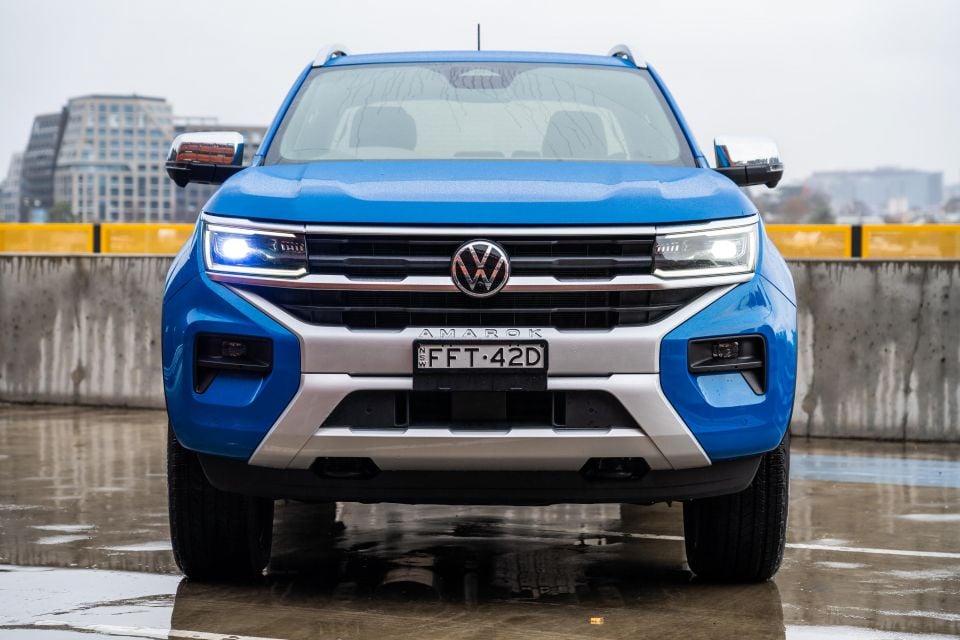
| Model | Price before on-road costs |
|---|---|
| 2024 Volkswagen Amarok Core TDI405 | $55,490 |
| 2024 Volkswagen Amarok Life TDI500 | $59,490 |
| 2024 Volkswagen Amarok Style TDI500 | $69,740 |
| 2024 Volkswagen Amarok Style TDI600 | $73,740 |
| 2024 Volkswagen Amarok PanAmericana TDI600 | $78,990 |
| 2024 Volkswagen Amarok Aventura TSI452 | $82,990 |
| 2024 Volkswagen Amarok Aventura TDI600 | $82,990 |
To see how the Amarok stacks up against its rivals, use our comparison tool.
If you somehow got inside without noticing the tray, you’d be forgiven for thinking this was simply an SUV.

It’s a nice interior; everything is sturdy and finished in quality materials that give it a surprisingly plush feel. Some of the first things you’ll notice in that department are the seats, which are upholstered in leather with earthy brown accents.
Those accents continue to the top of the dash, which is finished a brown colour that breaks up the black surfaces in the rest of the cabin – including the headliner. It’s a classy setup, and makes for an environment that’s enjoyable to spend time in.
You do still get the typical hard plastics and durable coverings you’d expect from a ute, but even they’re presented in an upmarket way. Take the shroud surrounding the gear selector for example, a hard plastic panel that looks like a piece of rock.
That clean, geometric design is carried throughout the cabin, with hard edges and sharp angles defining most of its key surfaces. Getting in is made easy too, with a pair of beefy handles on the A-pillars.
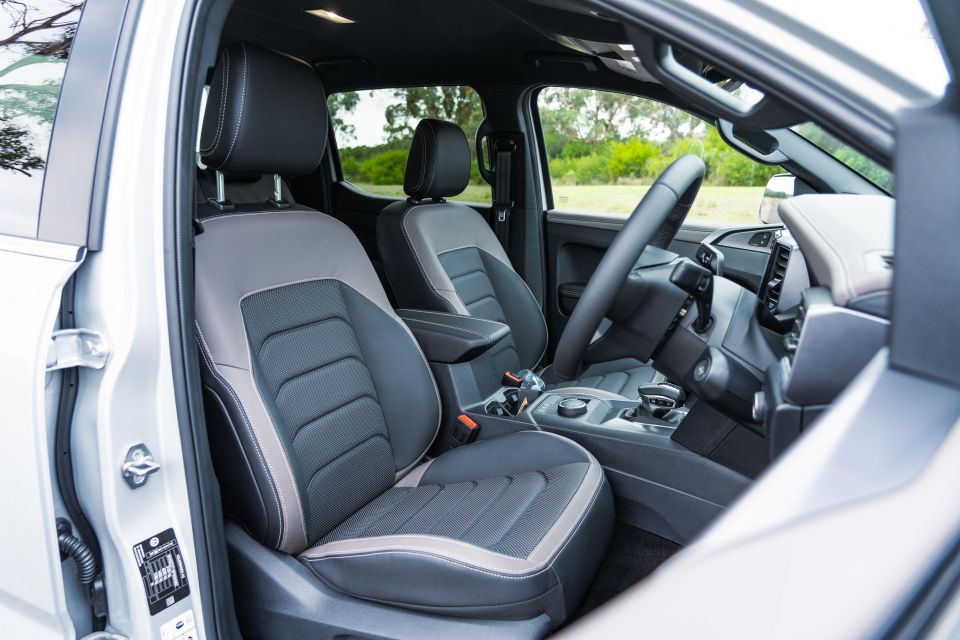
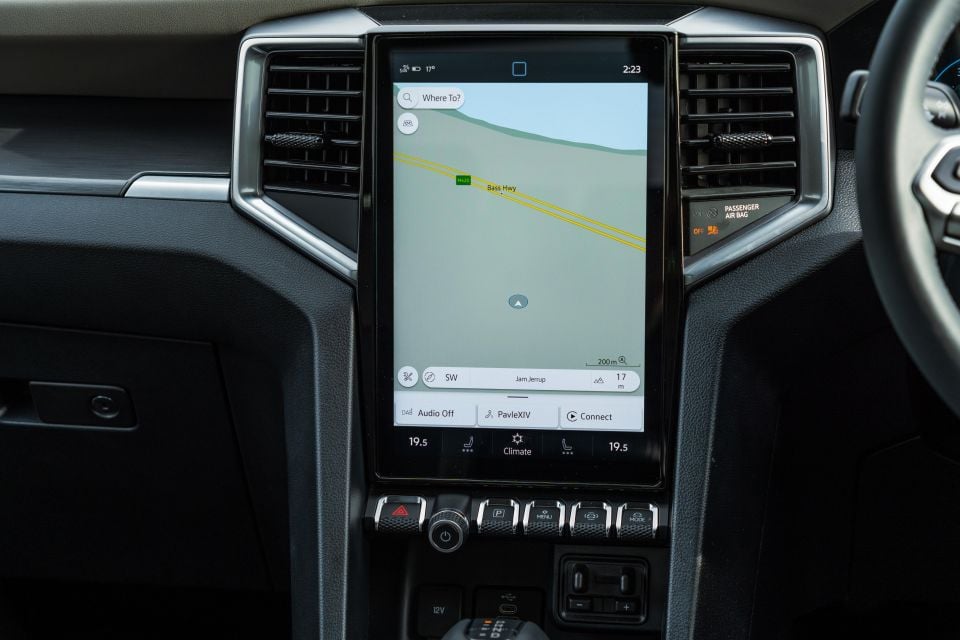
Then there’s the tech. One of the first things you’ll see is that huge vertical 12.0-inch infotainment screen, which has one of the best displays in the dual-cab ute class.
It’s very similar to the Ranger in that regard, though it’s graphically cleaner in the Amarok. That’s a general theme here, as there’s a lot less going on around the cabin in the Volkswagen compared to its mechanical twin.
In some ways, that does a lot to help it appear as a less intimidating experience when you first get inside. In other ways, it makes it seem like it isn’t as usable as it could be, or you like you don’t get as much control over the vehicle as you might in the button-laden Ranger.
For a start, there aren’t any physical buttons for climate control in the Amarok. Unfortunately this is nothing new for modern cars, but it is a bit tedious.
Temperature adjustment alone is needlessly indirect. You have to first press the number on the screen, which brings up a small slider to raise or lower the temperature. I would’ve liked some kind of rotary dial instead, but at least the numbers are always present on the screen.
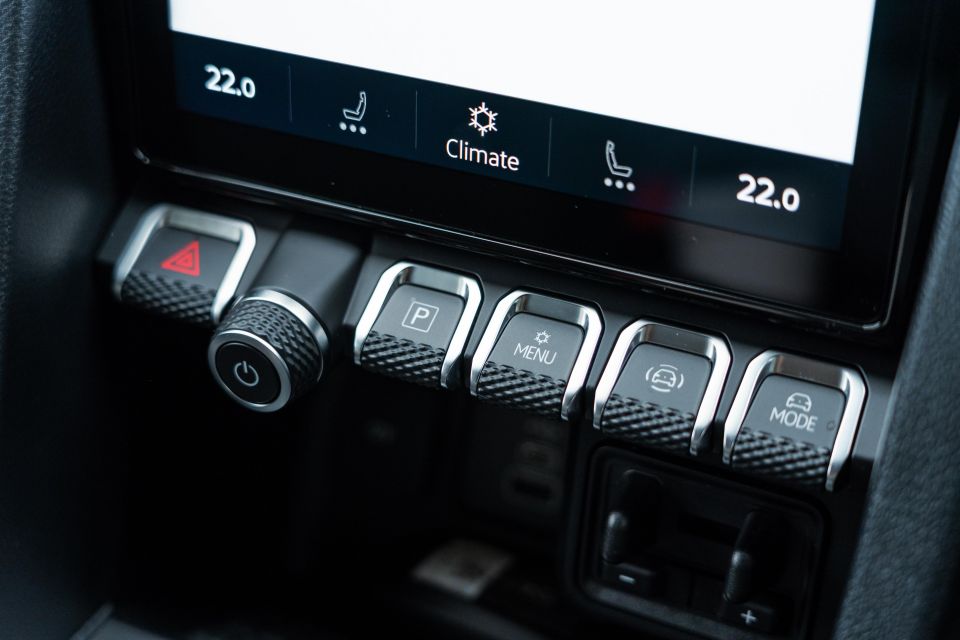
There are also separate buttons to bring up the same climate control menu, which are placed less than 10cm apart. One is a touch button at the base of the display, the other is a switch – which has a nice tactile feel – but you don’t need both. To avoid that, you can use convenient voice commands instead.
The controls for the front heated seats are at the bottom of the touchscreen too, which I’d again prefer to have as physical buttons. There’s plenty of room for some extra buttons on the centre console, so maybe a little more ‘clutter’ wouldn’t hurt for such functions.
Disabling things like the engine auto-stop function or adjusting the visual display can only be done by trawling through settings on that touchscreen.
At least in our week with the car the screen was always very responsive, but again there’s plenty of room for some of these controls to be given dedicated buttons elsewhere.
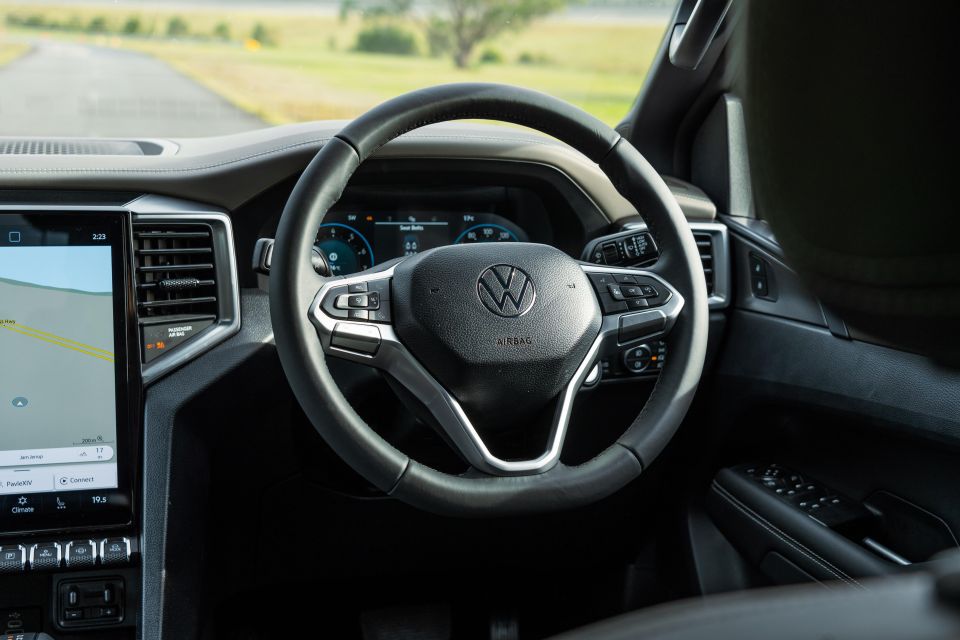
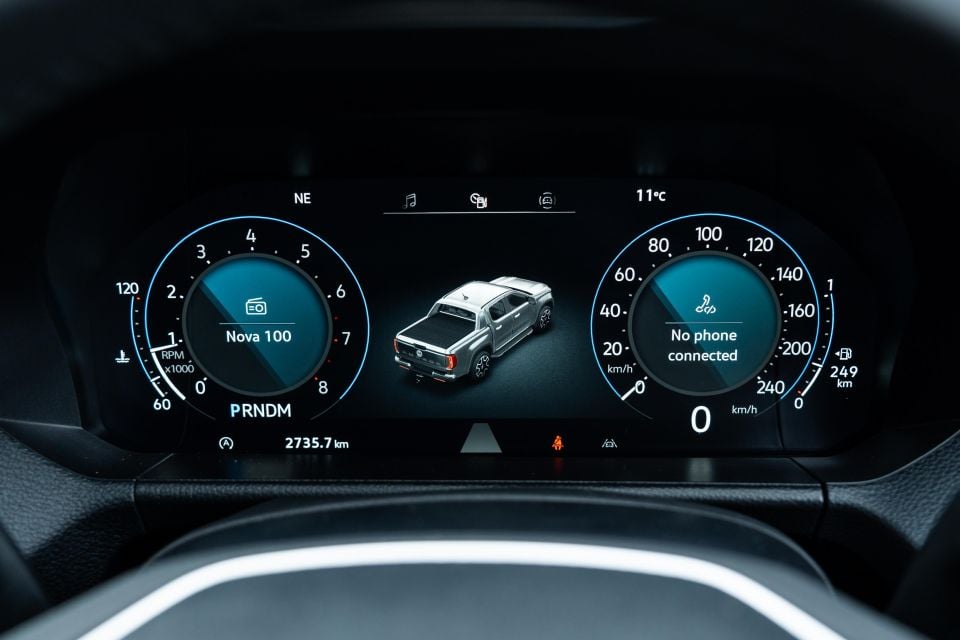
Ahead of the driver is a leather-wrapped steering wheel, which is refreshingly nice to interact with. There aren’t any haptic buttons, instead physical ones that all work as expected and don’t get in the way with both hands on the wheel.
The stalks behind the wheel all do exactly what you want too, with a solid feel and legible labelling. Other than that, there isn’t a huge amount for the driver to be interacting with on the road.
Behind the wheel is a 12.3-inch digital instrument display, which again is crisp and nice to look at. You get loads of information depending on which menu you have selected, and you’ll still get a digital tachometer and speedometer no matter what.
Its layout is simple and continues the borderline minimalist themes going on elsewhere, but it works well here. Everything you need to know is clearly laid out and easy to read, with nothing extra going on if you don’t want it.
If you do want more information, it’s easy to bring up any of the numerous displays using the buttons on the right-hand side of the wheel.
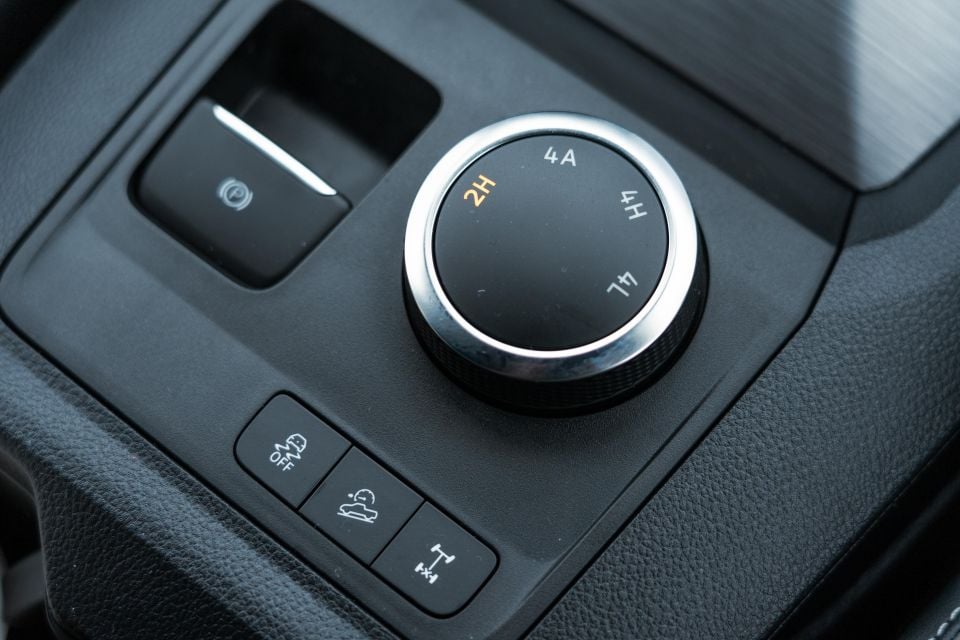
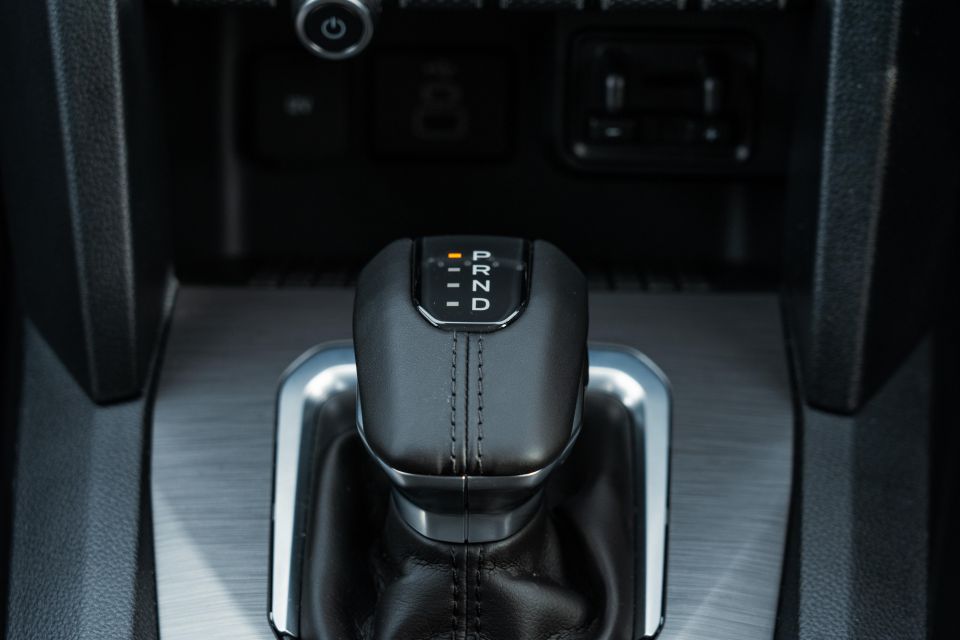
As for physical controls, the setup is disappointingly limited. There are five switches on the centre console for things like the driver assists and drive modes, which are situated above a control unit for towing adjustments.
There’s a stout gear selector with buttons for manual shifting in the thumb area, along with a large rotary dial for the four selectable 4×4 modes. You’ll find some extra buttons for traction control and hill descent here too.
Finishing it off is a large switch for the parking brake, which requires firm and deliberate action for it to engage or disengage. A quick flick won’t be noticed by the Amarok’s computer.
Connectivity and charging up front is done via either a USB-C or USB-A port, while there’s a 12-volt outlet and wireless charging pad too. All of this is placed in a tidy cubby ahead of the gear selector, nicely out of the way.
One of the interior quirks that came to the fore was its door handles, which are unconventional rectangular panels (as opposed to a standard lever) located inside the door armrests. While you’ll quickly find them and learn how they work, it was amusing to watch unassuming passengers poke, prod, and pull to try and figure it out.
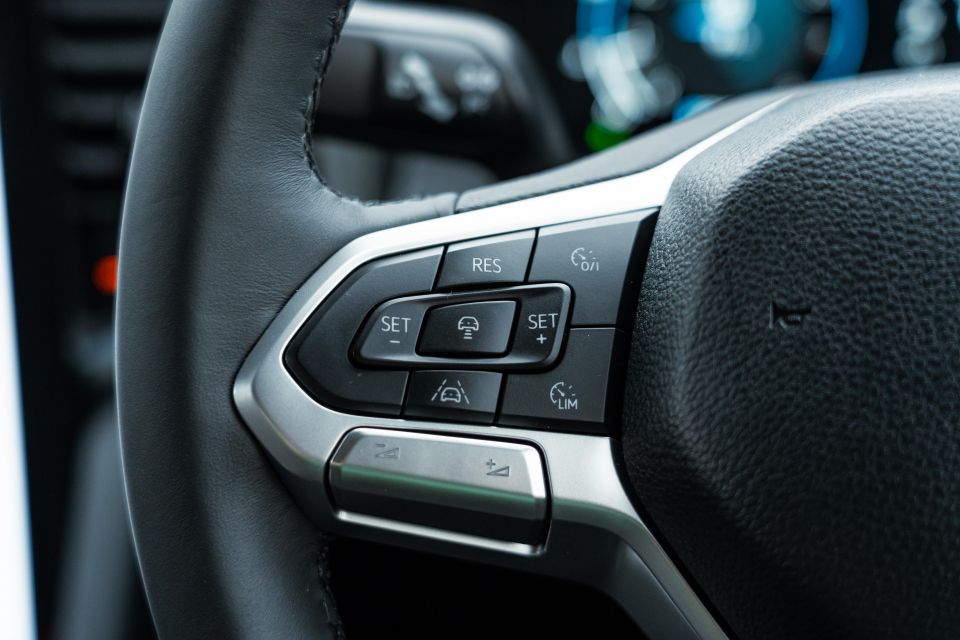
Perhaps the most significant difference between this and the Ranger is the cupholder and general storage situation.
There are fewer cupholders in the front; limited to just two on the centre console. They’re a little small and awkward to use, but if you need to fit a bottle there are dedicated spots in the door cards.
There are two storage boxes ahead of the passenger, both of which could do with being a bit larger. Underneath the central armrest is some more storage, giving you plenty of choice for various odds and ends.
To the Amarok’s benefit, it’s all integrated cleanly. At first glance, for example, you likely wouldn’t notice the upper dashboard storage area on the passenger side unless you were actively looking for it or someone showed you.
I like that about the Amarok’s interior – it’s generally unassuming, yet incredibly consistent throughout even if it can be lacking in some areas.
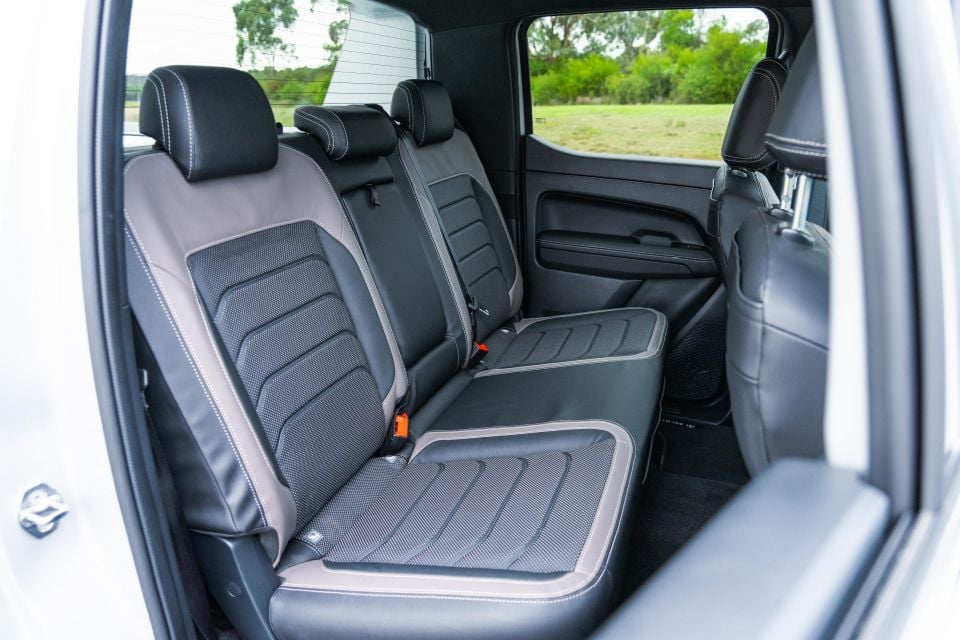
Stepping into the back is a small hike, but the side running boards make it easy to step up and in.
As is the case in all utes the rear doors don’t open particularly wide, which may make it difficult to get in if you’ve got mobility issues or need to load something larger like a child seat. Once you’re in, there’s certainly more than enough space to comfortably transport passengers or children.
If you need to fit a child seat, you’ll be able to utilise the two ISOFIX and two top-tether anchor points. In terms of amenities, there’s a fold-down centre armrest and a 12V outlet, but there are no USB outlets here.
The rear bench seats themselves are upholstered in the same material as the front, though they’re not as comfortable. Headroom is generous, though taller passengers might run into trouble with legroom if the front occupants are equally tall.
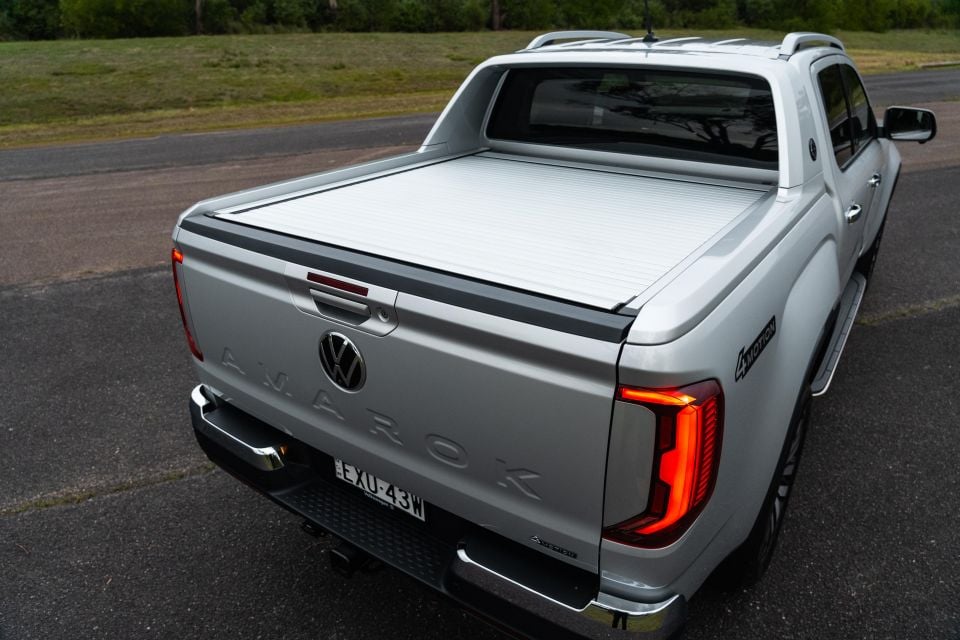
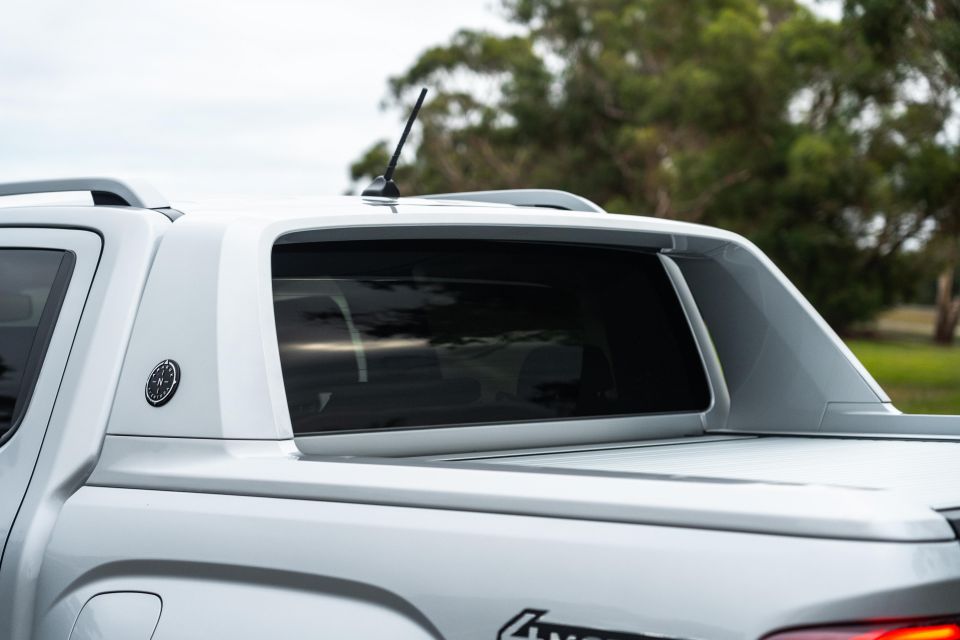
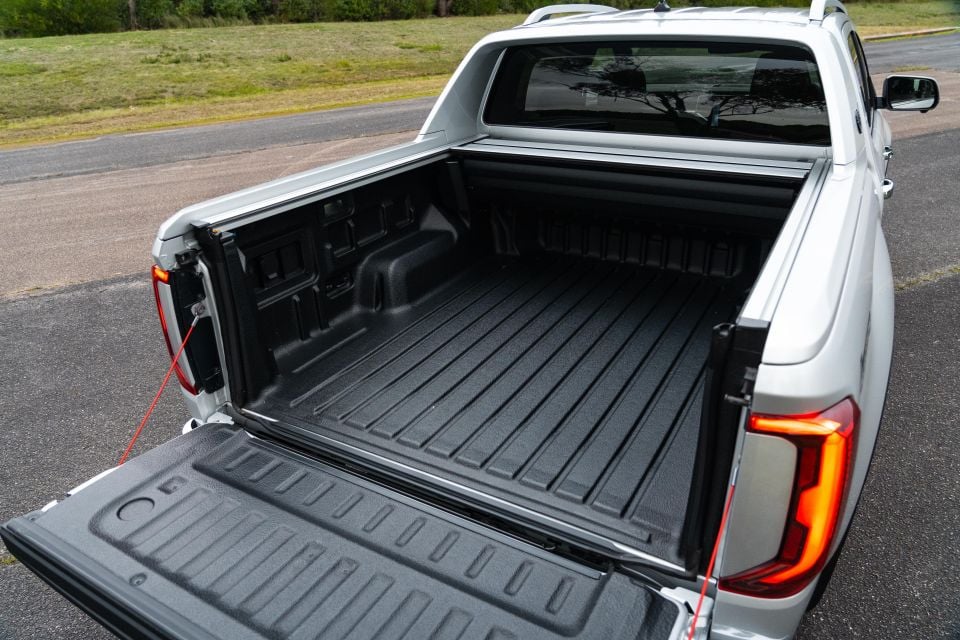
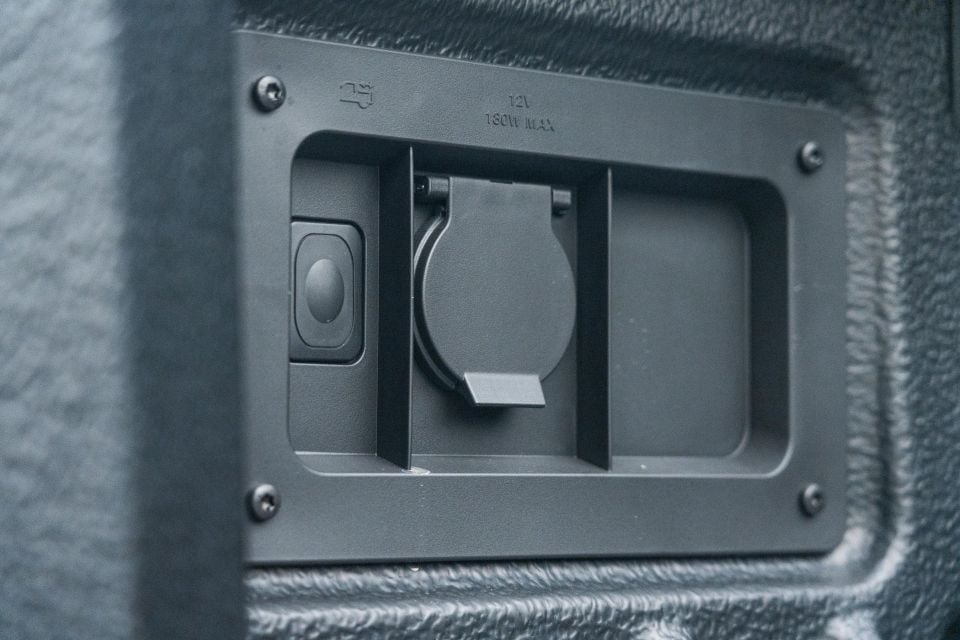
On top of that, the Harman Kardon-branded sound system is among the best-sounding setups on offer right now for the ute segment.
Out the back you get a lined tub, though I can’t help but feel the rest of the car almost feels too nice to be carrying around dirty machinery and tools – I’d feel bad scratching or staining the black plastic through general use.
The remote-controlled powered rolling tonneau cover is a nice addition, but it eats into vertical space at the front of the tub. I’d hate to accidentally get dirt in the cover’s rails too; it just seems like it’d become a headache if things started to get a bit crunchy.
Once you open the tailgate and slide back the cover though, you’ll find a 12V outlet, six tie-down points, and some lighting. Again it’s all perfectly usable, but I don’t know if you’d want to use it – at least not regularly.
| Dimensions | Volkswagen Amarok |
|---|---|
| Length | 5350mm |
| Width | 2208mm (1910mm excl. mirrors) |
| Height | 1886mm |
| Wheelbase | 3270mm |
| Ground clearance | 235mm |
| Tray length | 1544mm |
| Tray width | 1224mm |
| Tray depth | 529mm |
To see how the Amarok stacks up against its rivals, use our comparison tool.
With the range-topping Amarok you get a choice of either a petrol or a diesel engine. Our tester is fitted with the former, while the other option is a 3.0-litre V6 turbo-diesel with 184kW and 600Nm.
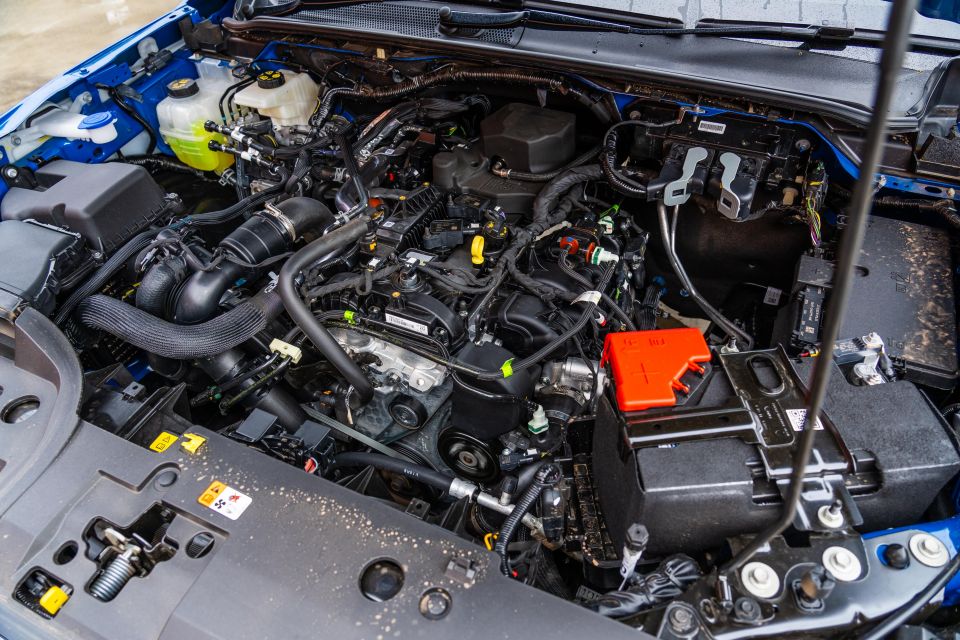
| Specifications | Volkswagen Amarok Aventura TSI452 |
|---|---|
| Engine | 2.3L 4cyl turbo-petrol |
| Power | 222kW |
| Torque | 452Nm |
| Transmission | 10-speed automatic |
| Drive type | Four-wheel drive with 4A |
| Fuel economy (claimed) | 9.7L/100km |
| Fuel economy (as tested) | 10.1L/100km |
| CO₂ emissions (claimed) | 222g/km |
| Fuel type | 95 RON |
| Fuel tank | 80L |
| Weight | 2293kg (kerb) |
| Payload | 807kg |
| Braked towing capacity | 3500kg |
| Gross vehicle mass (GVM) | 3100kg |
| Gross combination mass (GCM) | 6200kg |
To see how the Amarok stacks up against its rivals, use our comparison tool.
Given its unusual mechanics, it’d be wrong to say driving the TSI452 isn’t interesting on the road.
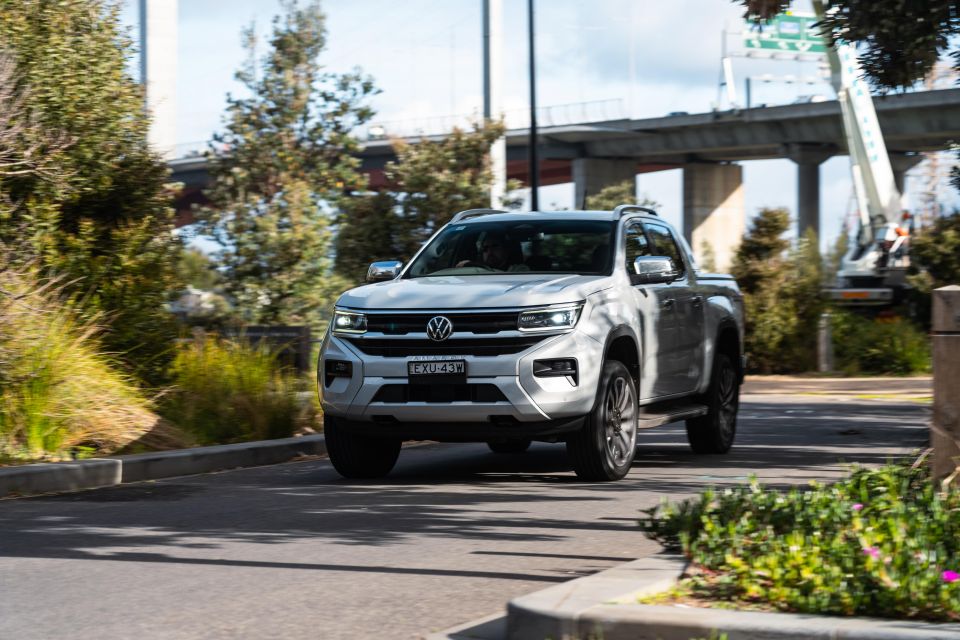
With the ute body you’d expect it to start with a diesel rumble, while the SUV interior suggests it’d be more refined.
I can best describe it as a mix of the two, because especially the cold idle of the TSI452 isn’t as smooth as a standard petrol engine but is still more pleasant than a truck.
Regardless, it starts up with the press of a button and warms up in no time at all. You can certainly hear the engine running, and from the outside it can sound quite tough.
Select drive and you’re ready to go, though it won’t take long to notice some of the quirks with the Amarok’s drivetrain.
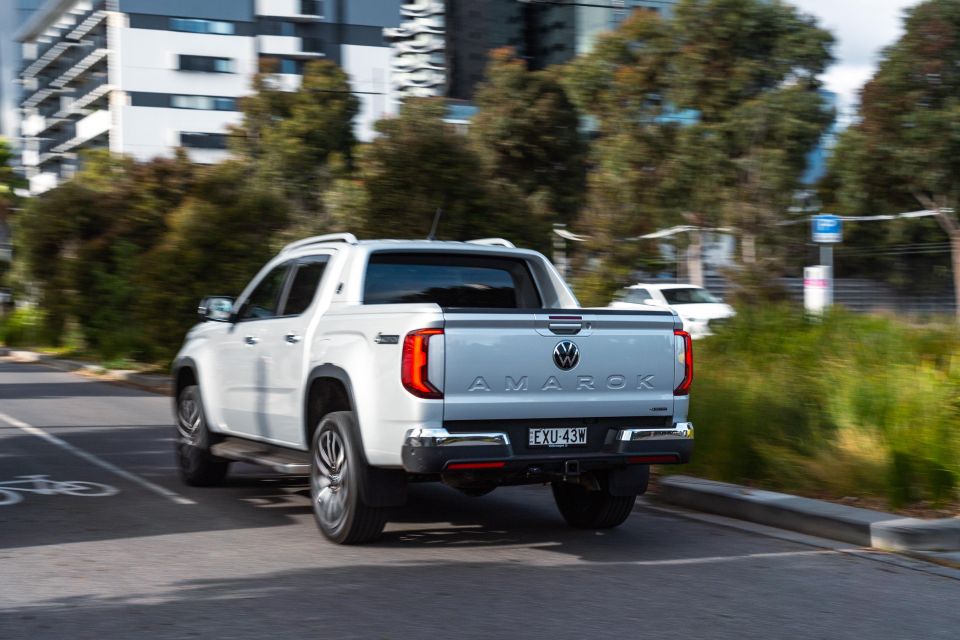
Where expert car reviews meet expert car buying – CarExpert gives you trusted advice, personalised service and real savings on your next new car.
Getting the power from the engine to the wheels is a 10-speed automatic transmission. While it gives you a lot of range in both high- and low-speed driving, it can sometimes seem like there are too many gears to the point where it doesn’t know what to do with itself.
With moderate throttle input from a standstill, it just doesn’t rev out in each gear as you’d expect it to.
It all means accelerating isn’t as satisfying as it could be in standard driving, but at least there are some ways around it. If you feel like embracing your inner lead foot, the Amarok’s transmission will hang onto gears longer and offers more punch.
You’ll notice with a hearty boot-full it revs up properly in each gear, shifts smoothly and at the right time, and really allows the petrol engine to give you the most of what it’s got. The other solution is to put it in manual mode, though controlling that requires you to keep one hand on the selector because there are no paddles behind the wheel.
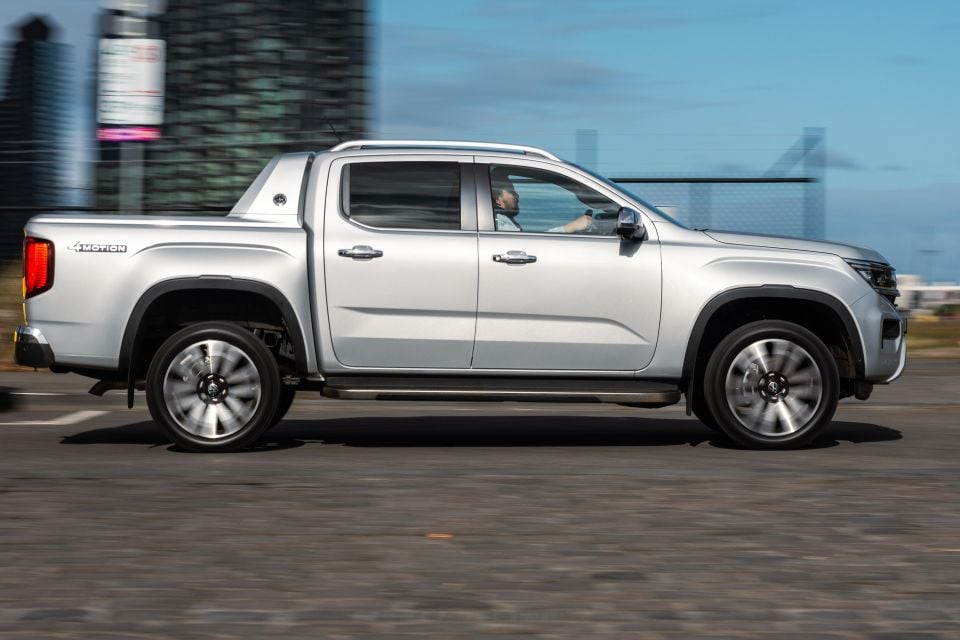
Beyond that, that engine is the main drawcard here. That’s a good thing too, because it’s an impressive engine.
Even though it’s a big car you still get all the typical characteristics of a turbocharged petrol engine, like that push in the back you get when boost kicks in. To make it that little bit sweeter, you can hear the turbo spooling under high load.
It sounds decent too, and while it could do with a couple of extra cylinders to take some of the stress off, there’s no denying the TSI452 is a surprisingly quick car.
The engine’s small displacement and lower torque output do mean it has to work harder than its diesel counterpart does, so if you’re going to be towing regularly I’d suggest this isn’t the Amarok for you.
It’s still fun to have that petrol engine though, and if you’re someone who will primarily use this car as an on-road daily with the odd off-road venture, it’s honestly quite a good setup.
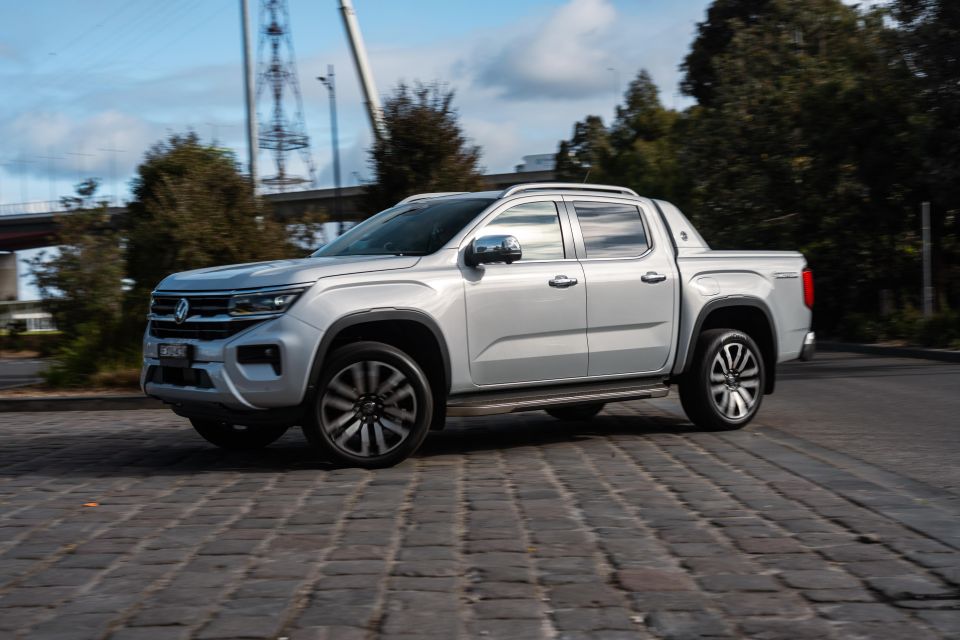
The on-road focus of the Aventura means its tyres have a much lower profile, which you definitely notice. It rides on stylish 21-inch alloys wrapped in 275/45 tyres, which look nice but do no favours in making the ride compliant over bumps.
Lower Amarok grades offer 17-inch wheels with chunkier 255/70 or 255/65 tyres instead, which do better both on rough roads and off the beaten track. If it’s aesthetics you’re after though, the Aventura has you covered.
Combine the slim tyres with the typical ride characteristics of a ute, and you get a rough ride over harsh bumps. Despite that, it’s a lot more plush than what you get in some of the ute competition, which backs up its on-road bias.
You won’t have any trouble driving it along the freeway over greater distances, as it’s impressively comfortable on the open road.
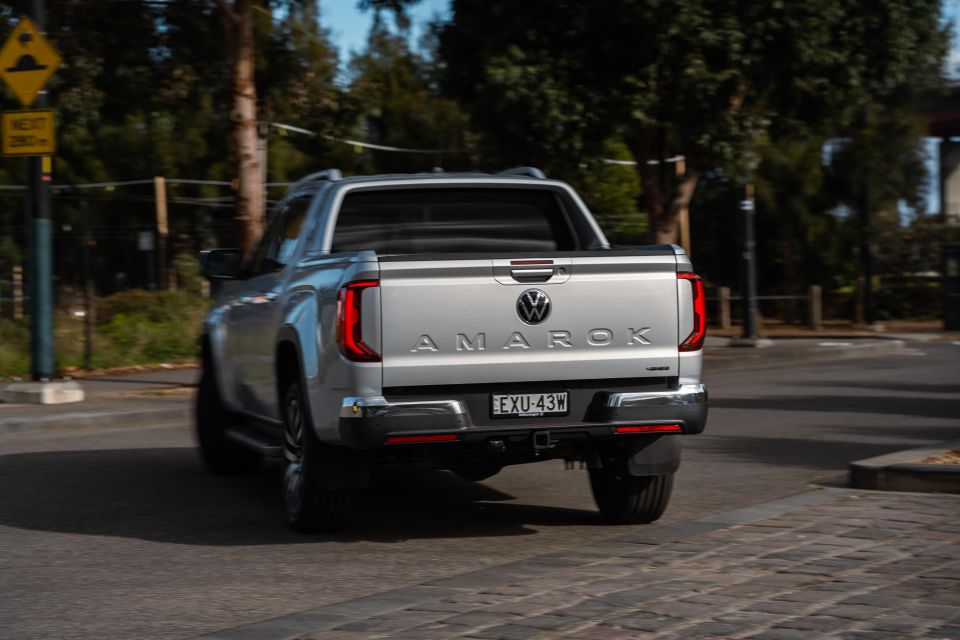
Helping out are driving assist features like adaptive cruise control and lane-keep assist, which make for effortless kilometres behind the wheel.
Such systems worked flawlessly during our week with the car, and the lane-keep function in particular did a decent job keeping the big rig centred in its lane.
It did have its hiccups though, like telling me to keep my hands on the wheel where they had been since I got moving. The same warnings came up when I had my hand on the wheel with adaptive cruise control and lane-keep enabled, which required a brief shake of the wheel to get it to stand down.
Blind-spot monitoring helped to avoid running people off the road, while there’s also a high-quality surround-view camera to help you into tight parking spaces.
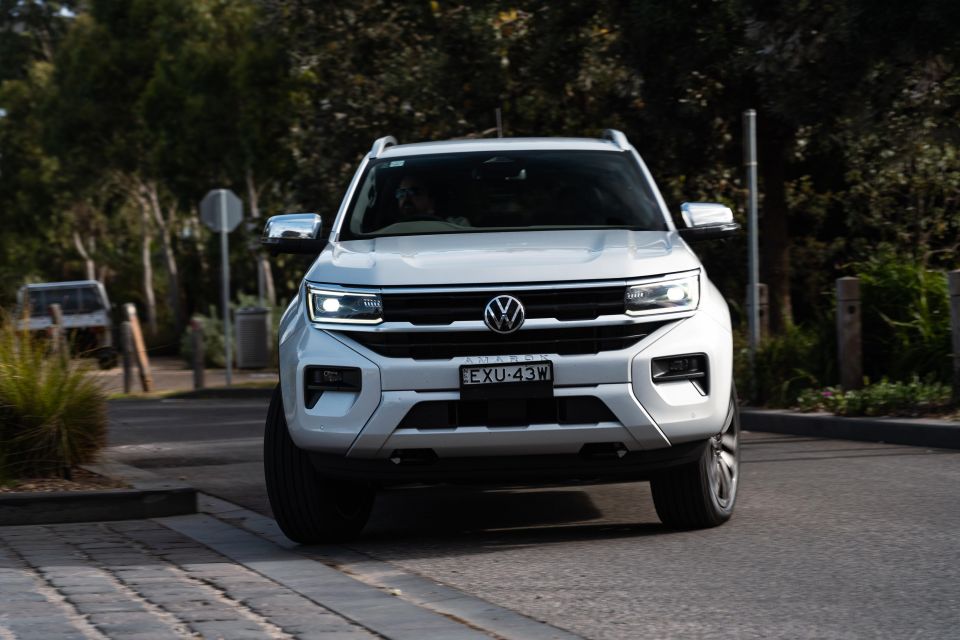
It’s not ideal as a city car because of its size, but if you pay attention it’s really not difficult to get it around. Its sensors and cameras help, but just take care in those parking garages with low clearance – it can feel like you’re going to hit your head from time to time.
While it does have selectable drive modes, solid ground clearance and long suspension travel, I’d avoid taking the Aventura off-road.
I’m sure if you do need to head down a brief trail it’d be just fine, but some more capable off-road tyres would do wonders to help it out for anything more serious.
All things considered, it really is a comfortable tourer with a tray. Compared to some other utes like the Mitsubishi Triton or Toyota HiLux, the Amarok Aventura presents the most like an SUV.
| Off-road dimensions | Volkswagen Amarok Aventura TSI452 |
|---|---|
| Track front and rear | 1620mm |
| Ground clearance | 235mm (unladen) |
| Approach angle | 30.0 degrees |
| Departure angle | 25.6 degrees |
| Ramp breakover angle | 22.0 degrees |
| Wading depth | 800mm |
To see how the Amarok stacks up against its rivals, use our comparison tool.
The Aventura stands out against other Amarok models thanks to its silver front bumper and chrome grille, side mirrors, and door handles, as well as its rear sailplane and electric roller cover.

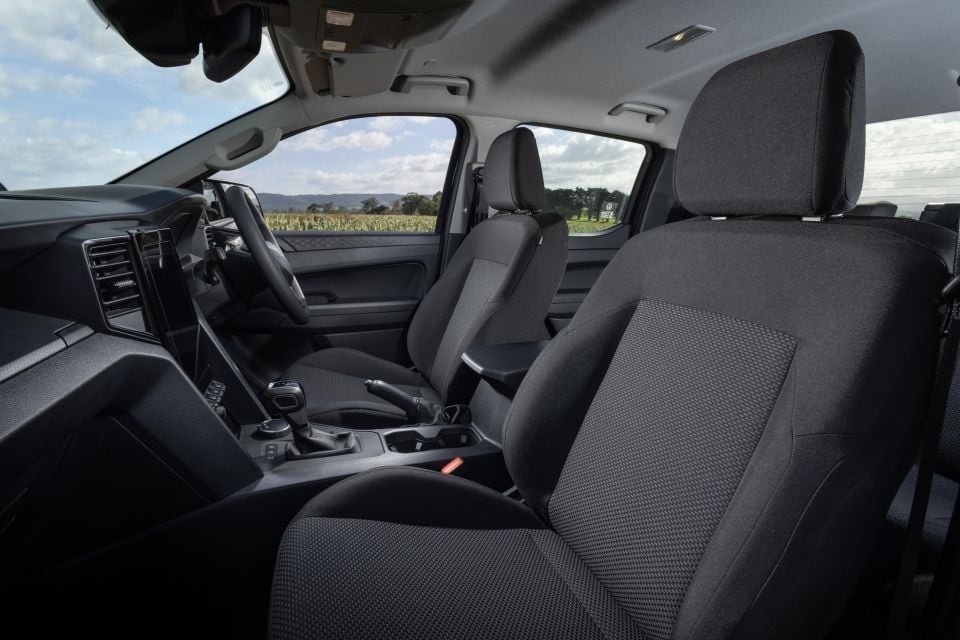

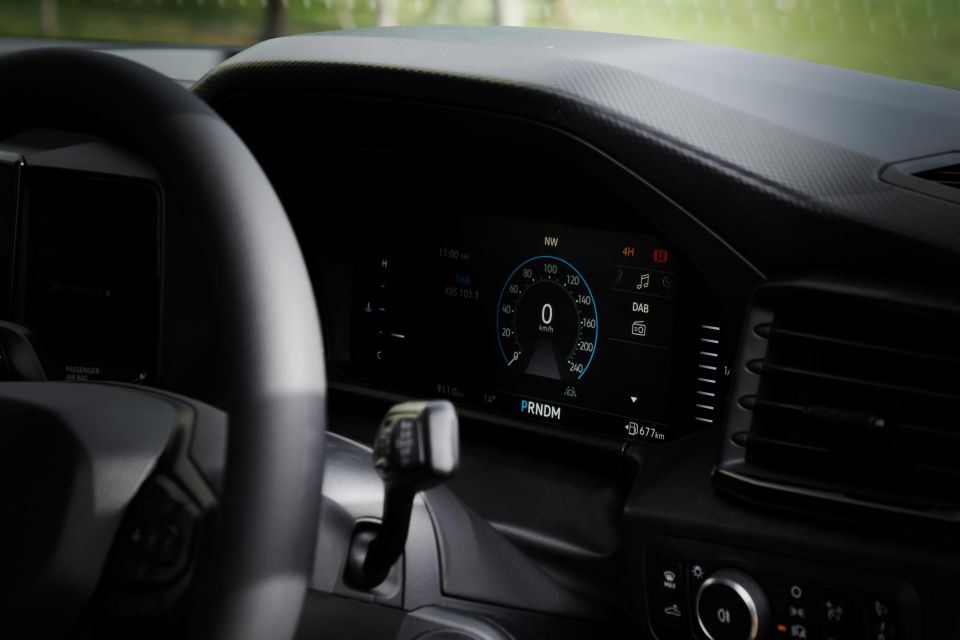
Standard equipment on the Amarok Core includes:
Exterior
Interior
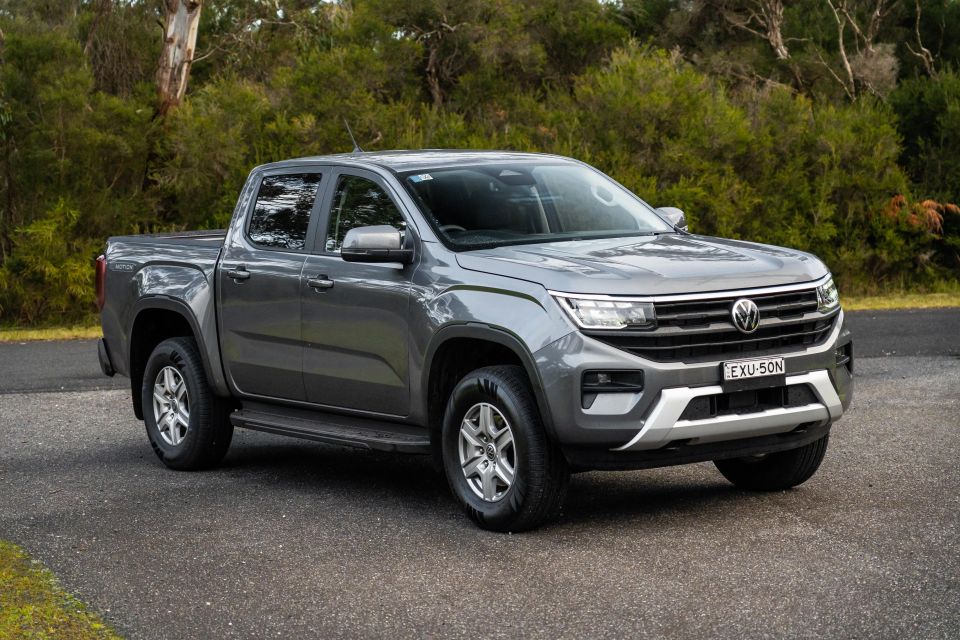
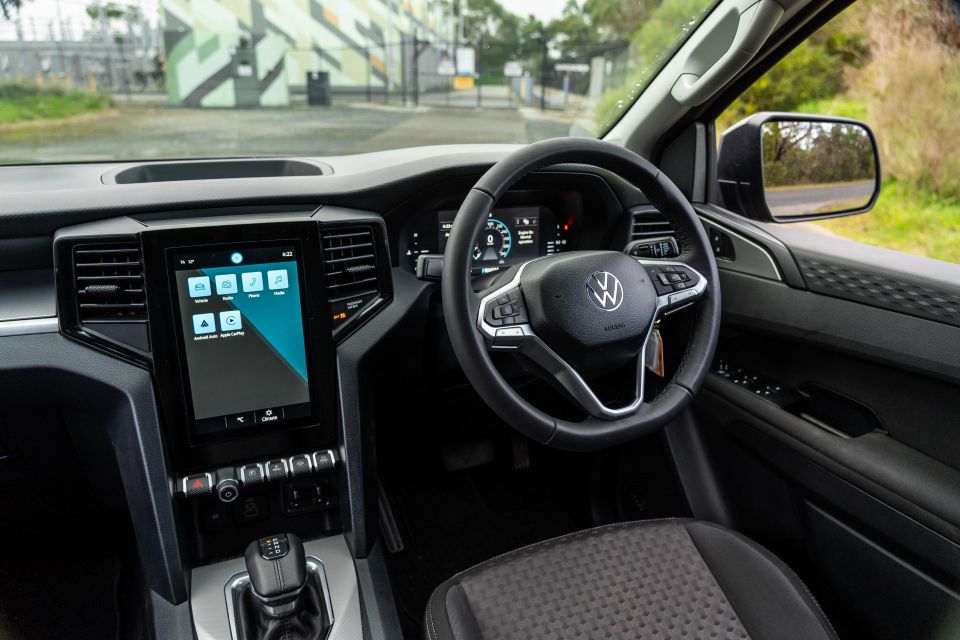
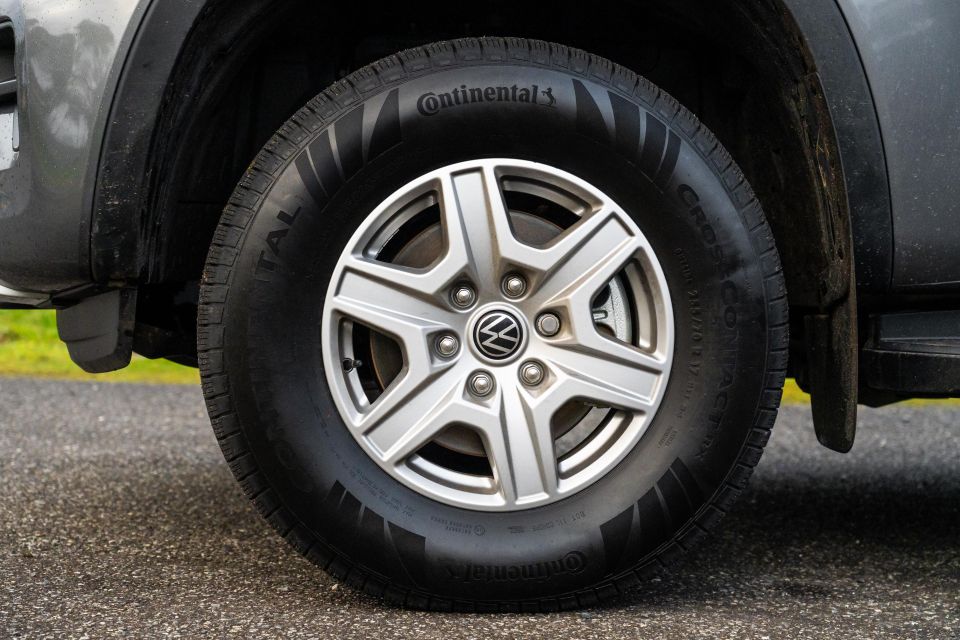
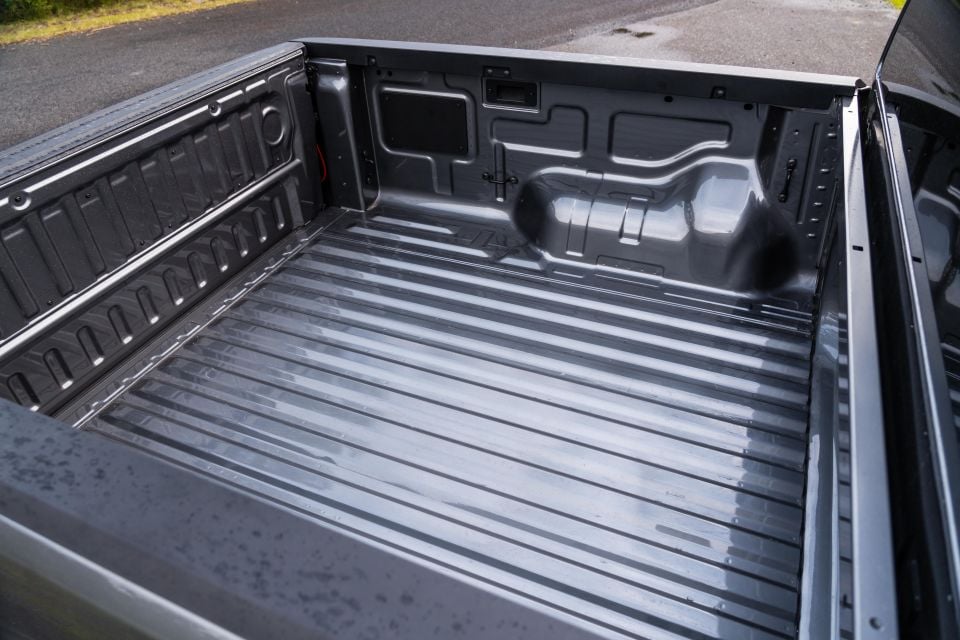
The Amarok Life adds:
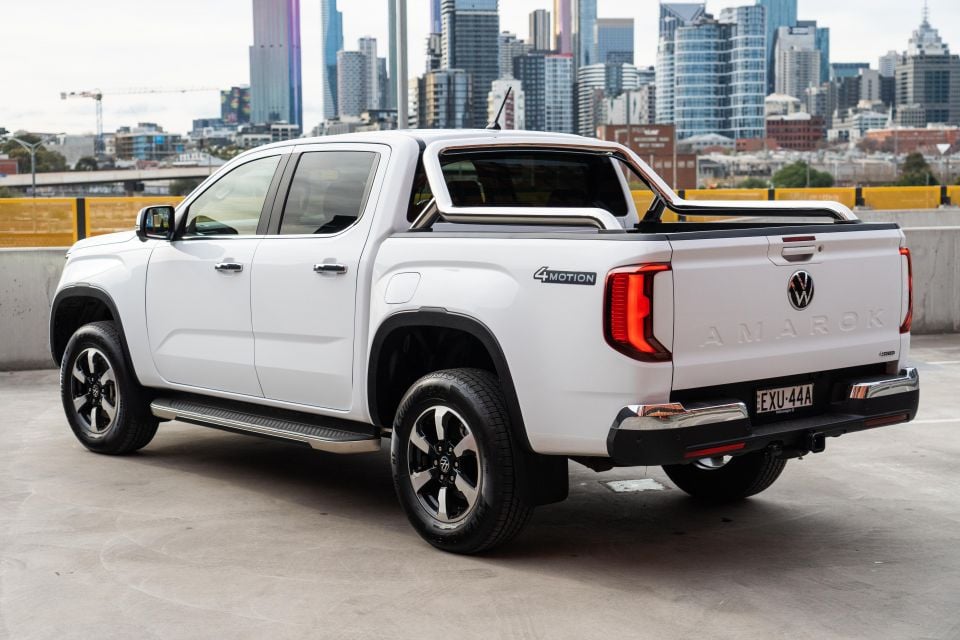
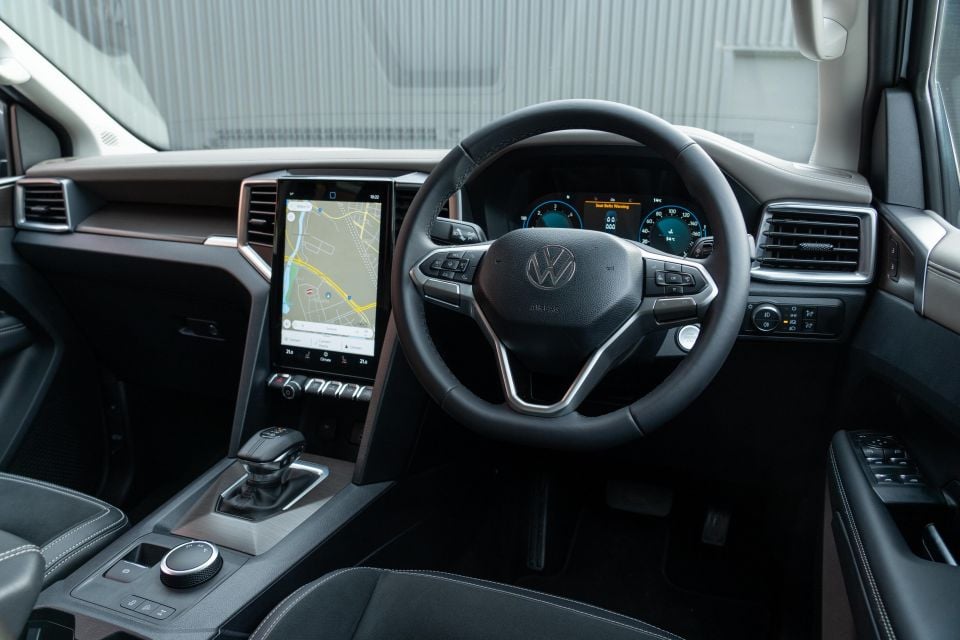
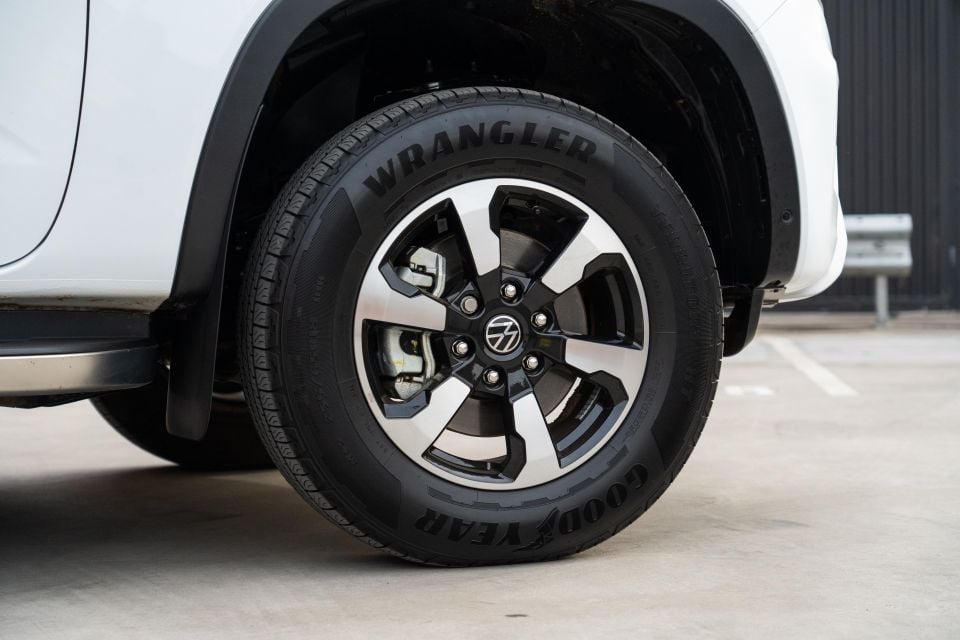
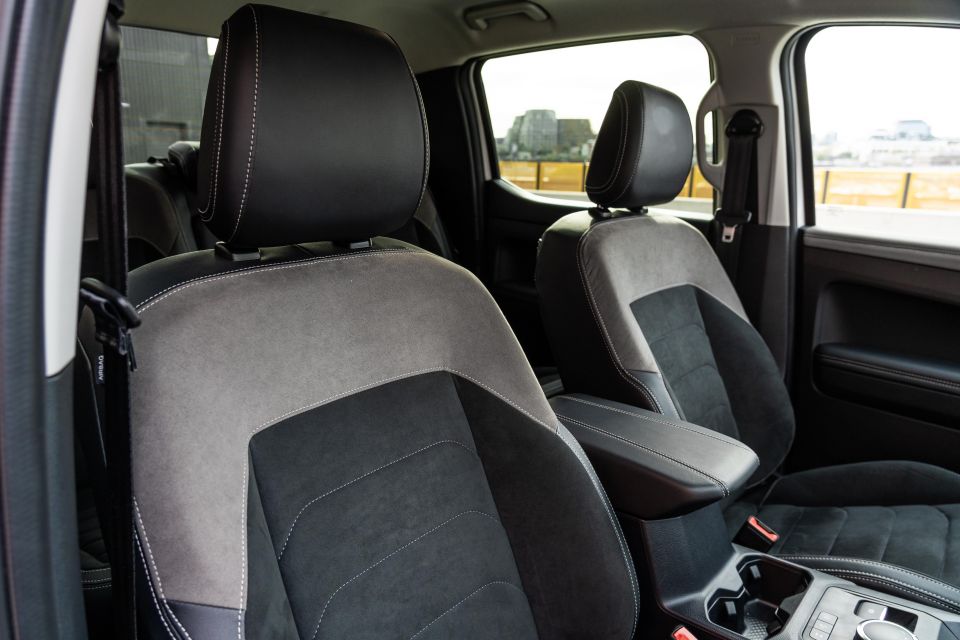
The Amarok Style adds:
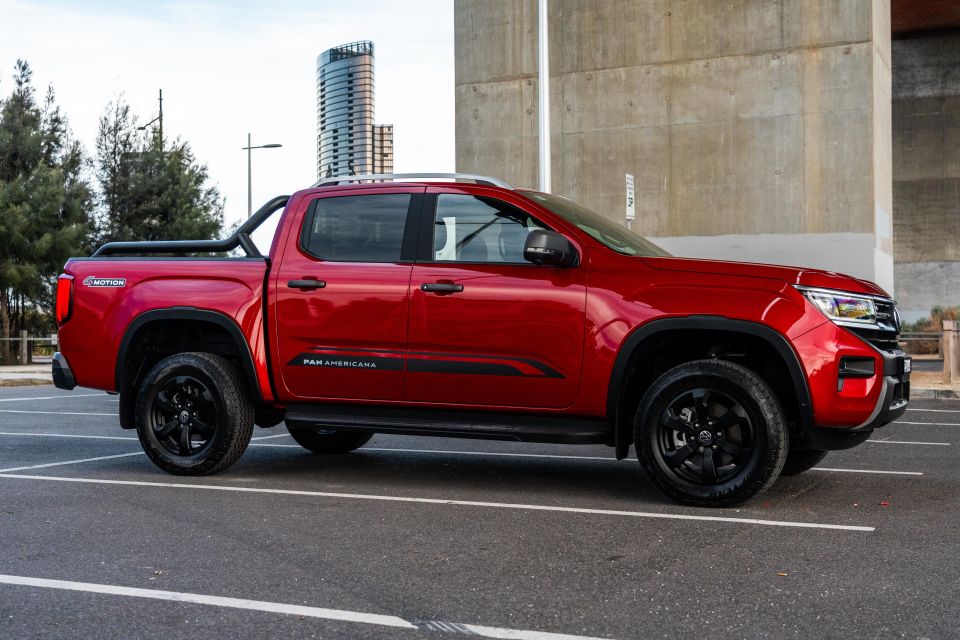

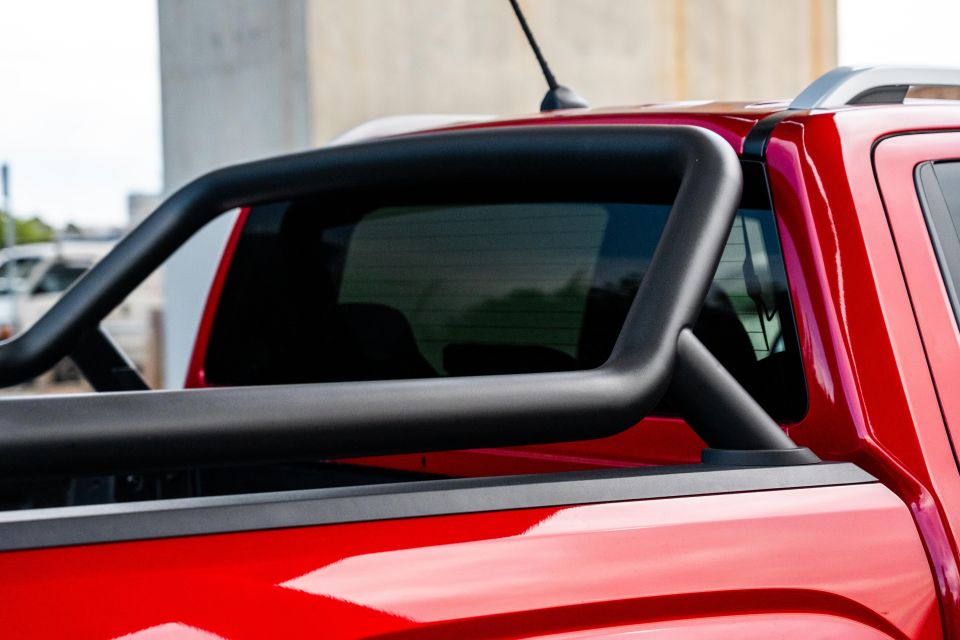
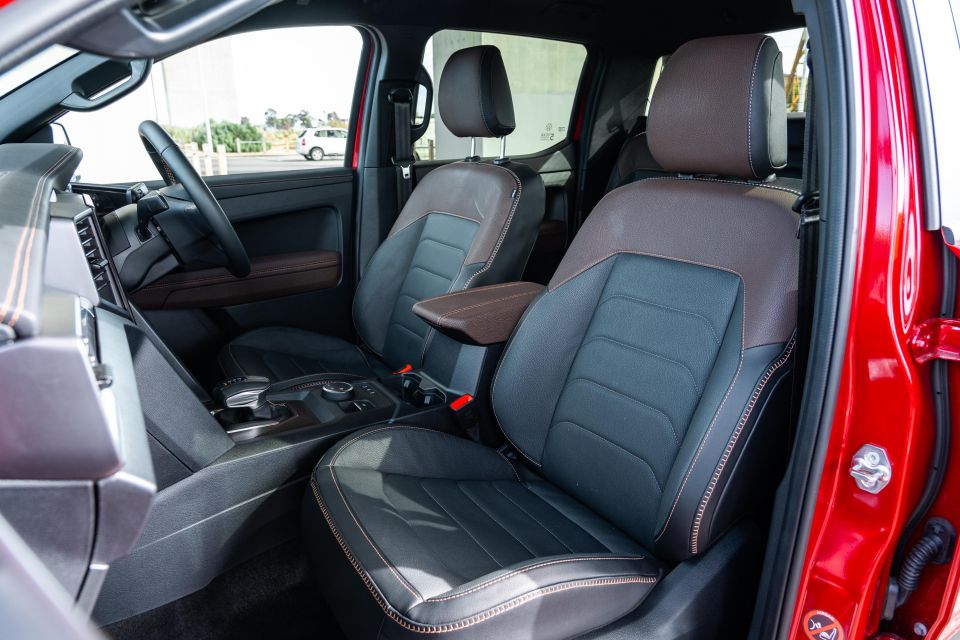
The Amarok PanAmericana adds:
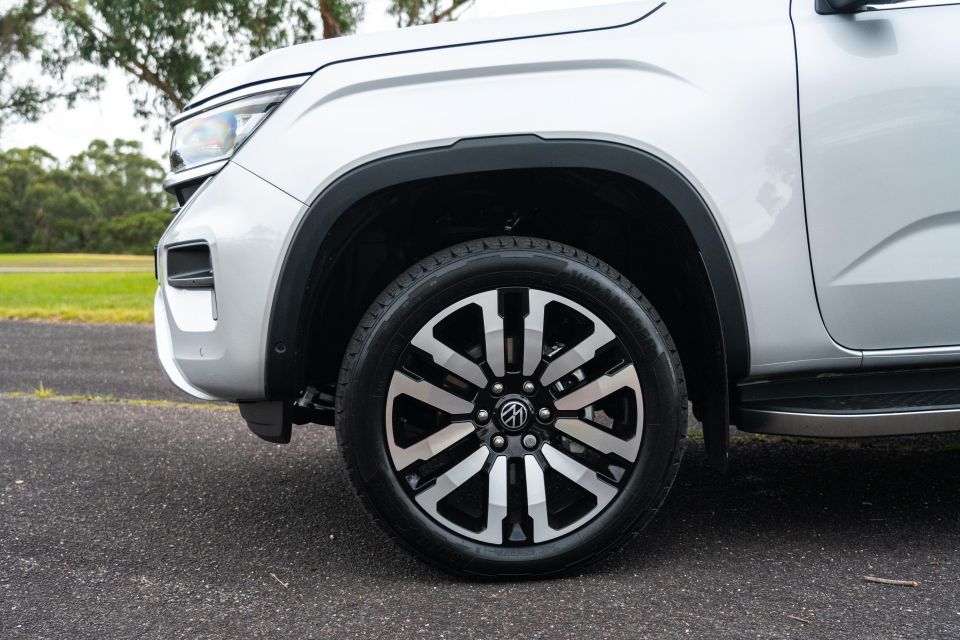
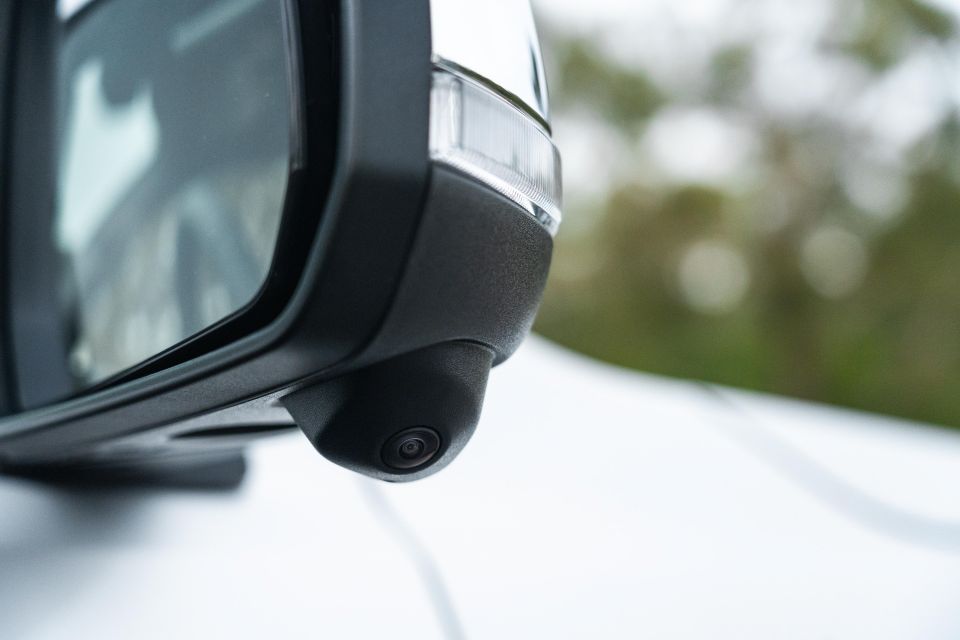


The Amarok Aventura adds:
The Volkswagen Amarok was awarded a five-star ANCAP safety rating based on testing in 2022.
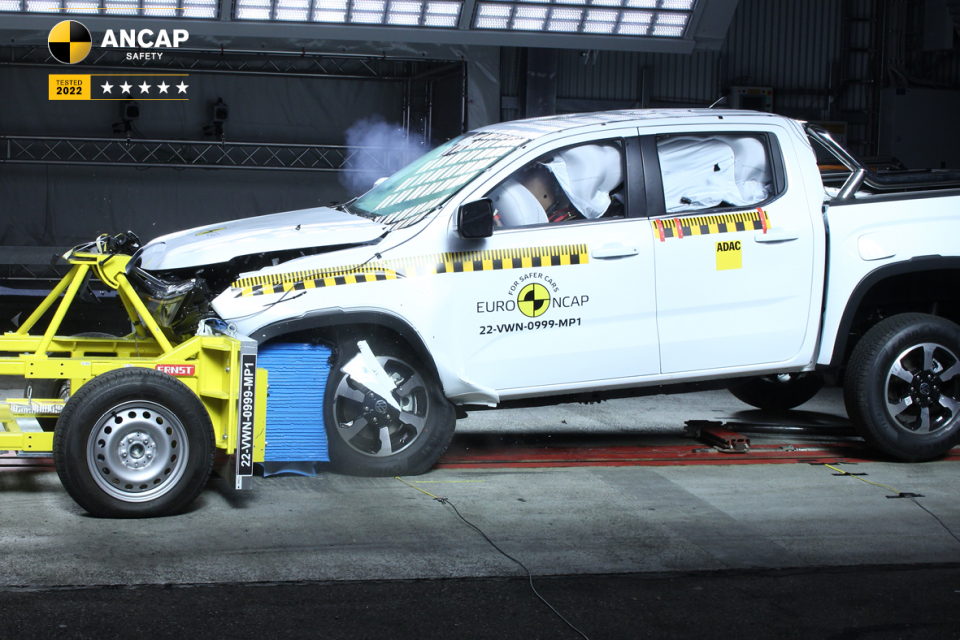
This result was drawn from testing of the closely related Ford Ranger, with additional frontal offset and side impact tests conducted on the Amarok by Euro NCAP, which has harmonised testing protocols with ANCAP.
| Category | Volkswagen Amarok |
|---|---|
| Adult occupant protection | 86 per cent (32.98 out of 38) |
| Child occupant protection | 93 per cent (46 out of 49) |
| Vulnerable road user protection | 74 per cent (39.96 out of 54) |
| Safety assist | 83 per cent (13.39 out of 16) |
Standard safety equipment across the range includes:
Amarok Life adds:
Amarok Style adds:
To see how the Amarok stacks up against its rivals, use our comparison tool.
Like the wider Volkswagen range, the Amarok is covered by a five-year, unlimited-kilometre warranty.
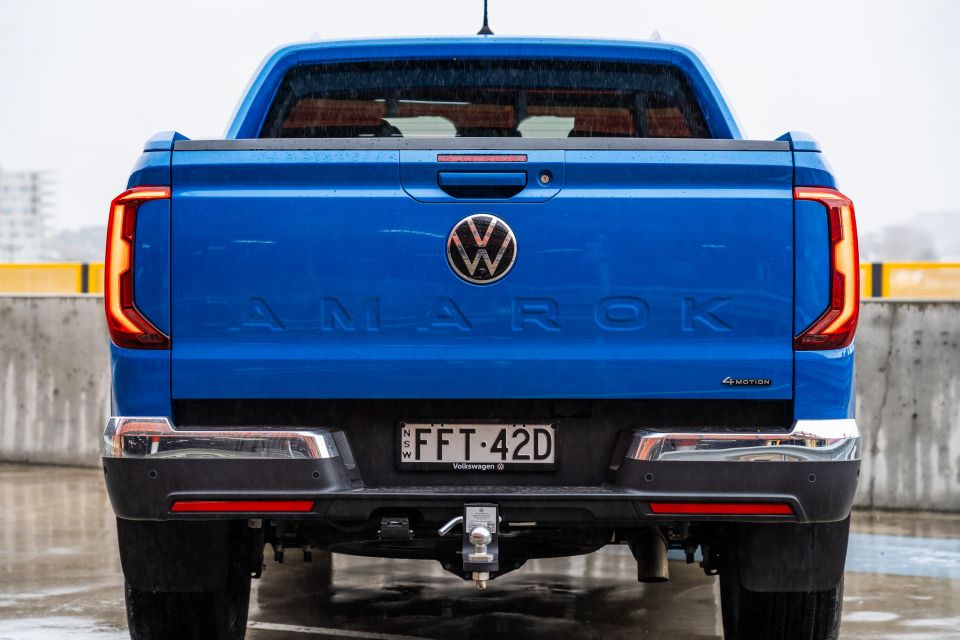
Volkswagen Australia also offers a five-year Care Plan which costs $1801. Additionally, owners will receive up to 12 months of roadside assistance if they service their vehicle within the Volkswagen dealer network.
| Running costs | Volkswagen Amarok |
|---|---|
| Warranty | 5 year, unlimited kilometres |
| Roadside assistance | 12 months (from purchase, then service-initiated) |
| Service intervals | 12 months or 15,000km |
| Capped price servicing | 5 years |
| Total capped price service cost | $1801 |
To see how the Amarok stacks up against its rivals, use our comparison tool.
As far as utes go, the Amarok Aventura is among the nicest you can buy right now.
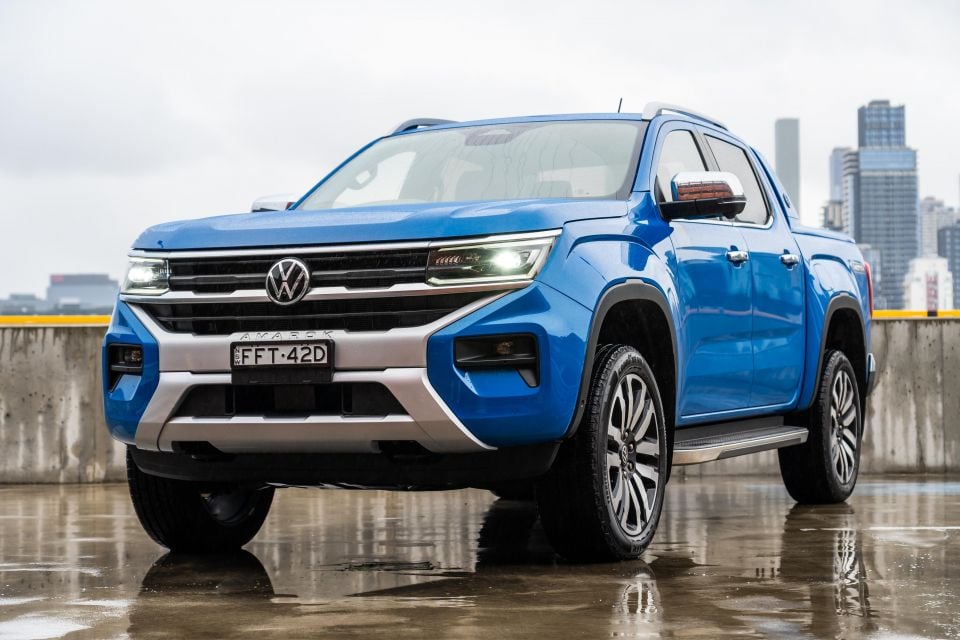
It’s a well-presented vehicle, helped by its large alloy wheels and subtle hints of chrome scattered around the body. That rear sailplane also does wonders to help it stand out against the lower Amarok grades.
Even the interior is done in a way that could easily convince you it was an upmarket SUV, and the tech works exactly as it should with hardly any major issues to speak of. It’s all clean and crisp, which is what you want from a car at this price point.
The assumption such a vehicle with a highly strung petrol engine would be interesting to drive rings true, because even if you were going on sound alone it’d be unique. It’s surprisingly quick with that 2.3-litre turbo tucked in there, even if it can be quite thirsty.
As with any car though, it isn’t perfect. The interior – while nice and classy – doesn’t offer the same practicality as some of its rivals.

Its simplicity is largely the reason it loses marks, as storage is relatively limited and too much is left to the touchscreen infotainment system. If there were just a few more physical buttons here and there, especially for climate control, it’d be greatly improved.
The transmission could do with some polishing as well, it feels like there’s an even more cohesive car that could be unlocked.
In the scope of an upmarket vehicle, the Aventura does well. As a ute, I just don’t think it’s the one to be going for if you’re going to be loading it up all the time. It really belongs on the road, but it’s almost too nice to put to work as a utility vehicle.
Do I think you’d be better off with a cheaper, hardier Amarok for a working ute? Yes. Do I think the the Aventura is more luxurious, mechanically special, and much more enjoyable to live with in the long run? Absolutely.
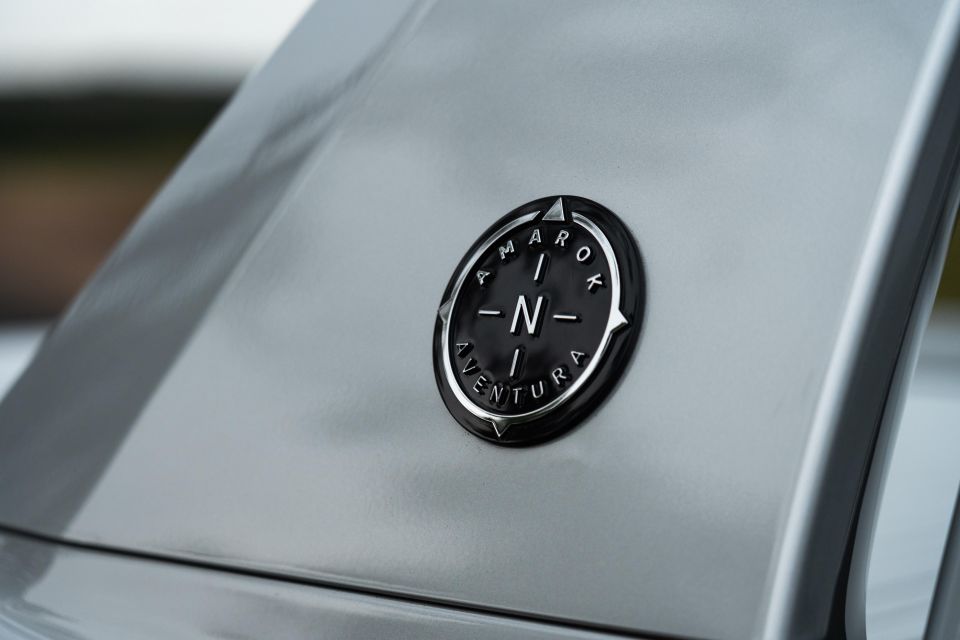
Click the images for the full gallery
MORE: Buy a Volkswagen Amarok MORE: Everything Volkswagen Amarok
Where expert car reviews meet expert car buying – CarExpert gives you trusted advice, personalised service and real savings on your next new car.
Max Davies is an automotive journalist based in Melbourne, Australia. Max studied journalism at La Trobe University and stepped into the automotive world after graduating in late 2023. He grew up in regional Victoria, and with a passion for everything motorsport is a fan of Fernando Alonso.


William Stopford
1 Month Ago


Paul Maric
22 Days Ago


Max Davies
16 Days Ago
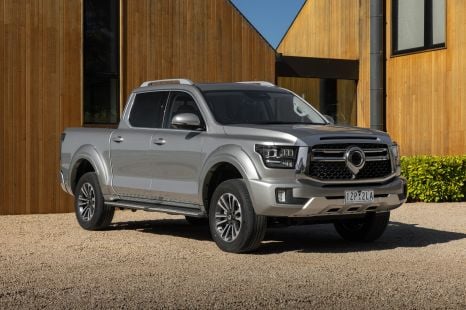

Marton Pettendy
9 Days Ago


Josh Nevett
8 Days Ago
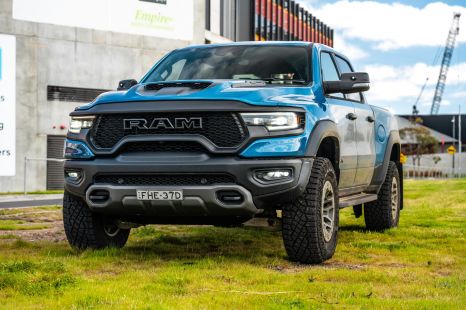

Max Davies
7 Days Ago